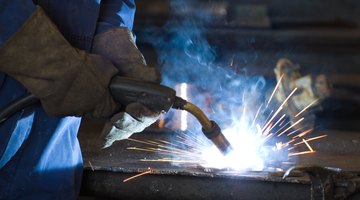What Cuts Through Steel?
Steel, an alloy of iron, is one of the strongest, hardest, most versatile and most common building materials. There are hundreds of types of steel, each designed for particular uses. Most saws are steel, too, which presents a problem for steel-bladed saws if what you want to cut is steel.

There are two things, however, that can cut steel very well: carbon and fire.
Carbon
The most abundant element in the universe is carbon. Human beings are substantially comprised of carbon, as are many life forms and minerals. Graphite is a form of carbon that is so soft it is used as pencil “lead.” Diamond is a form of carbon that is one of the hardest substances known. Diamond is used to coat the tips of steel-cutting blades, as is another carbon product called carbide.
Carbide
Carbide is a hard compound composed of carbon and other elements that are less electronegative than carbon. For steel-cutting, the favored carbide is tungsten carbide. Tungsten carbide is composed of about half carbon and half tungsten. Found naturally in powder form, the material is cemented to create tips for chisels and saw teeth. Tungsten carbide, called simple “carbide” in the building trades, is three times harder than steel; and when placed on circular saw blades, reciprocating saw blades and grinder discs, tungsten carbide cuts cleanly through steel.
Circular Saws, Reciprocating Saws and Grinders
Circular saws that cut steel include hand circular saws with carbide blades, table saws and chop saws. The blade spins as it passes through the metal. Reciprocating saws, commonly called sawzalls, are two-handed saws with straight blades that cut with a slight oscillating action. Sawzalls also use carbide blades for steel-cutting. Angle grinders employ abrasive discs that essentially sand their way through materials. For steel cutting, grinders may use either carbide or diamond as an abrasive.
Cutting Torches
Oxygen-fuel mixes that are concentrated can burn extremely hot. Cutting torches are special torches with concentrator tips that mix oxygen with acetylene or gasoline and deliver the mix under high pressure to a very small point. Oxy-actylene and oxy-gasoline cutting torches can reach temperatures above 6,000 degrees F; and the highest melting point of any steel is approximately 2,800 degrees. The cutting torch operator simply directs the tip of the flame onto the steel at the desired point, then draws the flame slowly across the cut-line as the metal separates.
The Drip Cap
- Steel, an alloy of iron, is one of the strongest, hardest, most versatile and most common building materials.
- The most abundant element in the universe is carbon.
- Carbide is a hard compound composed of carbon and other elements that are less electronegative than carbon.
- Found naturally in powder form, the material is cemented to create tips for chisels and saw teeth.
- Oxygen-fuel mixes that are concentrated can burn extremely hot.
References
Resources
Writer Bio
Stanley Goff began writing in 1995. He has published four books: "Hideous Dream," "Full Spectrum Disorder," "Sex & War" and "Energy War," as well as articles, commentary and monographs online. Goff has a Bachelor of Arts in English from the University of the State of New York.
Photo Credits
- Jupiterimages/Photos.com/Getty Images
- Jupiterimages/Photos.com/Getty Images
More Articles



